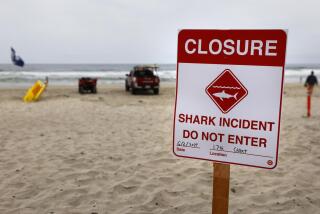Cutting to the Chase in Sharks’ Lair
For four years he sold real estate. His goal was to join the corporate world; he aspired to become a stock broker.
But somewhere along the line, while studying to obtain a license to sell securities, Ascanio Pignatelli realized that he had stumbled onto the wrong path.
“I woke up and realized that that’s not what life’s all about,” he said. “Life is about exploring and adventure. Life is an amazing thing. I want to do it all and see it all. I want to go everywhere and I want to try everything.”
With this new outlook, Pignatelli traded his business suit for a wetsuit, and with a few kicks of his swim fins he left the corporate world behind.
Now a certified dive master, he isn’t sure where this watery path will ultimately lead. But he likes where he has gone so far. Most recently, that has been deep into the realm of the shark, as co-host of a Travel Channel series called “Shark Chasers.”
The four-episode series, a Burrud production conceived by Pignatelli and also starring actor JD Roberto, is scheduled to air during the summer and should be a treat for anyone who appreciates this remarkable animal.
Unlike other shark specials, “Shark Chasers” puts fun ahead of science, relying on the wit of the two hosts while still giving viewers a clear understanding of how these predators behave.
Its hosts are not experts but rather personable and articulate young men “doing something the average diver can actually do,” said Pignatelli, 31, of Santa Monica. “It’s just two guys on an adventure getting up close and personal with sharks.”
That’s somewhat of an overstatement. The average diver might have trouble affording trips to the Bahamas, South Africa, Cocos Island (off Costa Rica) and French Polynesia--where the four episodes were filmed. Once at any of these locations, the average diver might not be so inclined or even allowed to hand feed a 10-foot lemon shark, or to grab a much larger great white by the snout and lift its head out of the water, which the hosts were able to do.
But the average diver can visit these destinations--and get up close and personal with sharks.
During a lunch last Friday in Marina del Rey, Pignatelli discussed his travels while offering, for review, a rough cut of the Bahamas show.
In that episode, the hosts are treated to a tour of the colorful reefs and ghostly wrecks off Nassau as guests of Stuart Cove’s Dive Bahamas. The Coves are renowned for their shark dives and visit areas that are teeming with Caribbean reef sharks.
To ease qualms the average diver might have about swimming with so many large sharks, Pignatelli and Roberto take a group of a school-age children snorkeling in an area where the rulers of the reef are clearly visible from the deck of the boat. One by one, Pignatelli coaxes the children into the water.
“And almost all of them made it back in one piece,” he later joked.
Gathering their scuba gear and communication equipment, the hosts then embark on a dive scooter-powered adventure though gin-clear lagoons, talking to one another about encounters with creatures large and small.
A highlight of the 52-minute episode includes a shark-feeding operation involving a large crate of fish parts set on the bottom, dozens of circling sharks and spears that are used to safely deliver the fish to the sharks.
The sharks, most measuring five to eight feet, can be seen swimming through the divers’ legs, between their outstretched arms, showing interest only in the fish being taken from the crate, and in the crate itself.
After the feed, Pignatelli is able to fulfill one of his dreams: to lure a large shark into his arms and immobilize it by gently rubbing his metal-meshed glove along the top of its head.
The metal in the gloves, it is explained, interferes with a shark’s highly developed sensory system and renders the animal motionless until the rubbing is stopped.
“It seems really hard and all that but actually it’s quite simple and it’s incredible fun,” Pignatelli said. “I had dreams about that dive. I swear to God I had dreams that night.”
*
The filming of “Shark Chasers” began last May in South Africa and concluded last month in French Polynesia.
South Africa didn’t feature a lot of sharks, but those that were encountered were great whites, including one seen from above water that caused the jaw of even the seasoned guide to drop because of its incredible size and girth.
“It was a 20-footer and that’s as big as they get,” Pignatelli said.
It won’t be seen on the TV show because everyone “was too blown away” by its size to get their cameras out, Pignatelli said. “The two things I remember most distinctly are that he had absolutely no scars, unlike all the other sharks we saw, and his girth was just enormous. He was probably six feet wide.”
In South Africa, as in Australia, scuba divers observe great whites from within the safety of a submerged cage.
Pignatelli had hoped to swim freely among the sharks “because I didn’t want them to be falsely portrayed as aggressive man-eating animals, because that’s simply not true.” However, the production company insisted that a cage be used.
What will make the show is considerable footage shot from within the cage, showing how cautious these apex predators really are while inspecting potential food items.
What may or may not make the cut is a segment showing Roberto lifting the head of a large great white out of the water with his hand.
“[The guides] don’t let anyone do this,” Pignatelli said. “We were allowed only because of the big bucks, the exposure they were receiving, and partially due to the fact they thought that shark chasers were shark experts.”
The real experts are well-versed in the precarious art of shark-lifting. The predators are baited to the boat and grabbed by the snout, and because the snout is so sensitive the shark is careful not to move so its head can be lifted partially out of the water.
“It sounds so gnarly but it’s not,” Pignatelli said. “Because when you grab sharks by the nose they become entranced.”
*
At Cocos Island, a pristine wonderland 300 miles off Costa Rica’s west coast, “I had my best day of diving ever,” Pignatelli said. “It was our first encounter with countless hammerheads ... just nonstop hammerheads and white-tips everywhere. You’d probably see 200 white-tips on every dive. I mean, it starts to get boring after a while: You’re almost pushing them out of the way because you want to see other stuff.”
At French Polynesia, the divers visited three islands--Tahiti, Moorea and Rangiroa--and encountered eight species of sharks.
Whereas Pignatelli fed sharks with a spear at the Bahamas, he was able to do it by hand in French Polynesia.
“These guys here are a lot more wild-west,” he says. “The guys at Stuart Cove’s did not take a chance of anyone getting hurt, but in French Polynesia there are no rules.”
Actually, there was one piece of advice: Let go of the chunk of fish after the shark grabs hold of it, lest you risk having your arm pulled from its socket.
Pignatelli’s subject was a 10- to 12-foot lemon shark. Lying still on the bottom, in the middle of a cloud of small reef fish trying to get at the bait, he could not see any of the large sharks circling the cloud.
All of a sudden, the little fish vanished, and the bigger of the sharks was at the end of Pignatelli’s outstretched arm, biting down on the hunk of fish without taking so much as a finger.
“They said that when a shark grabs, you let go because you cannot win the tug-of-war,” Pignatelli said. “Well, I had spent six dives and three hours of bottom time trying to feed this one shark--there’s no way I’m going to give up this piece of fish.
“Well, he grabbed it and twisted with all his muscle and almost ripped my arm off. He ripped the fish away but then he also dropped it, so I immediately grabbed it and everyone laughed. It was my little victory.”
More to Read
Sign up for The Wild
We’ll help you find the best places to hike, bike and run, as well as the perfect silent spots for meditation and yoga.
You may occasionally receive promotional content from the Los Angeles Times.






